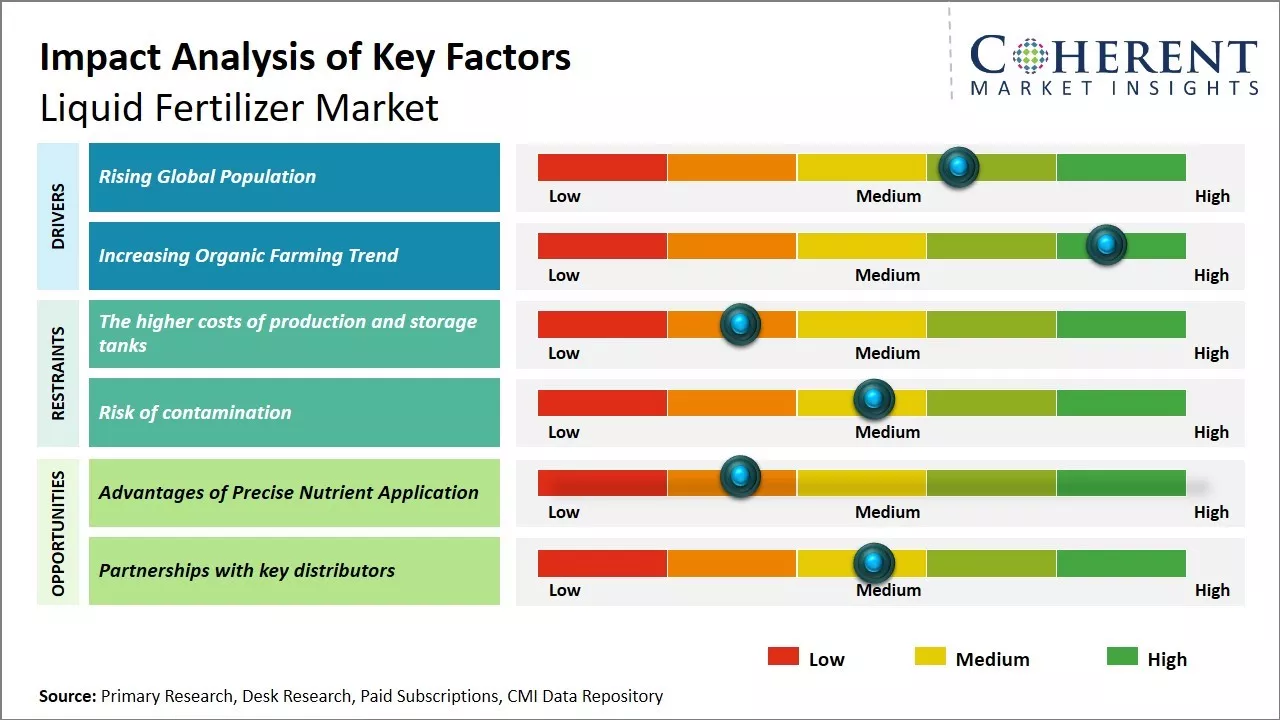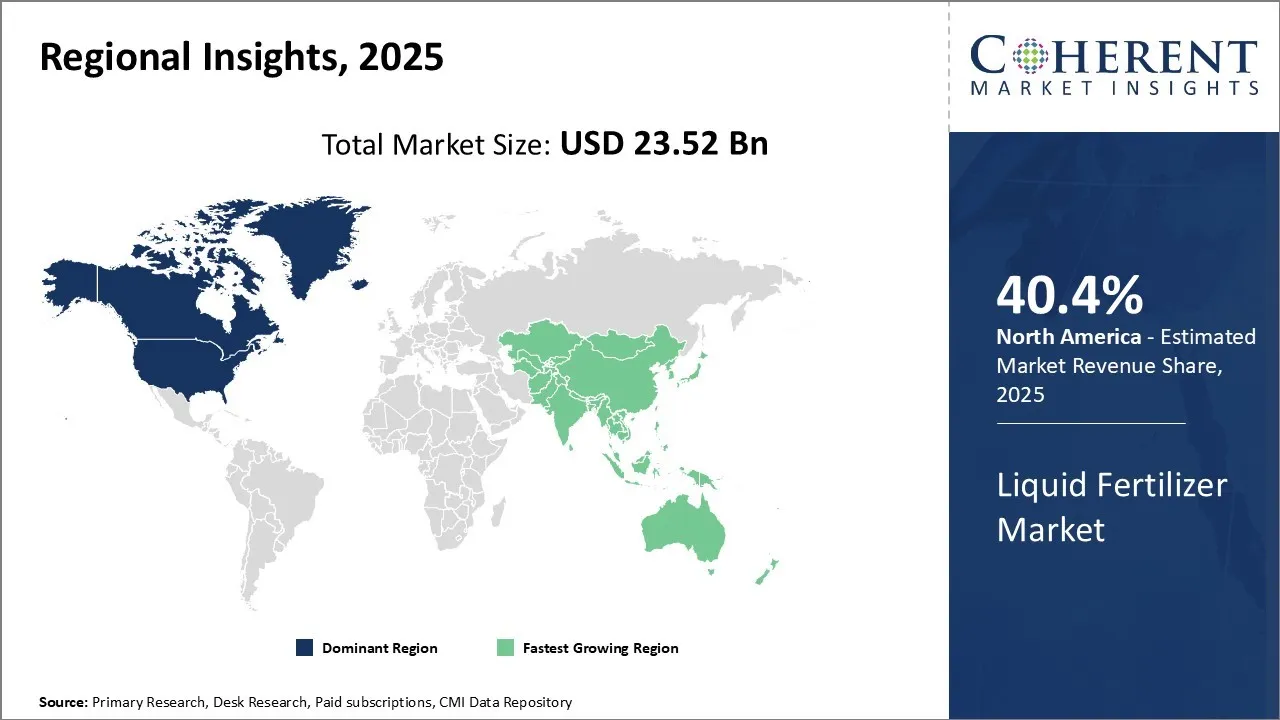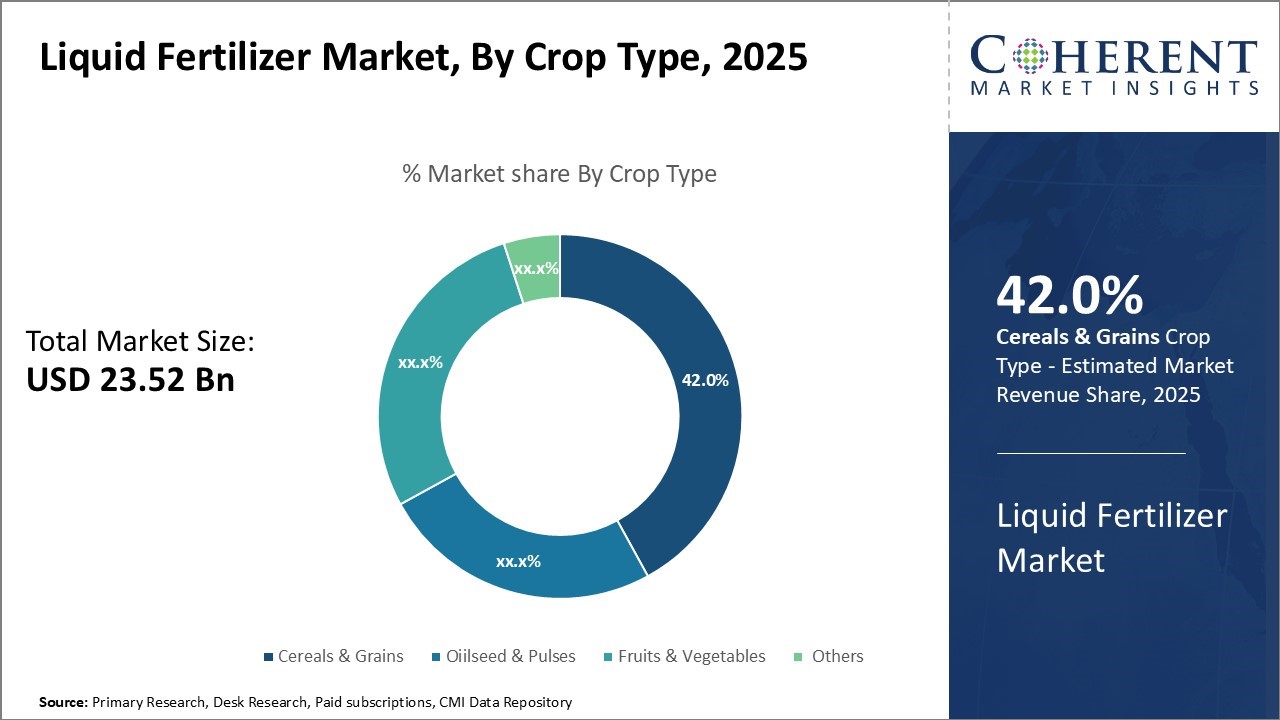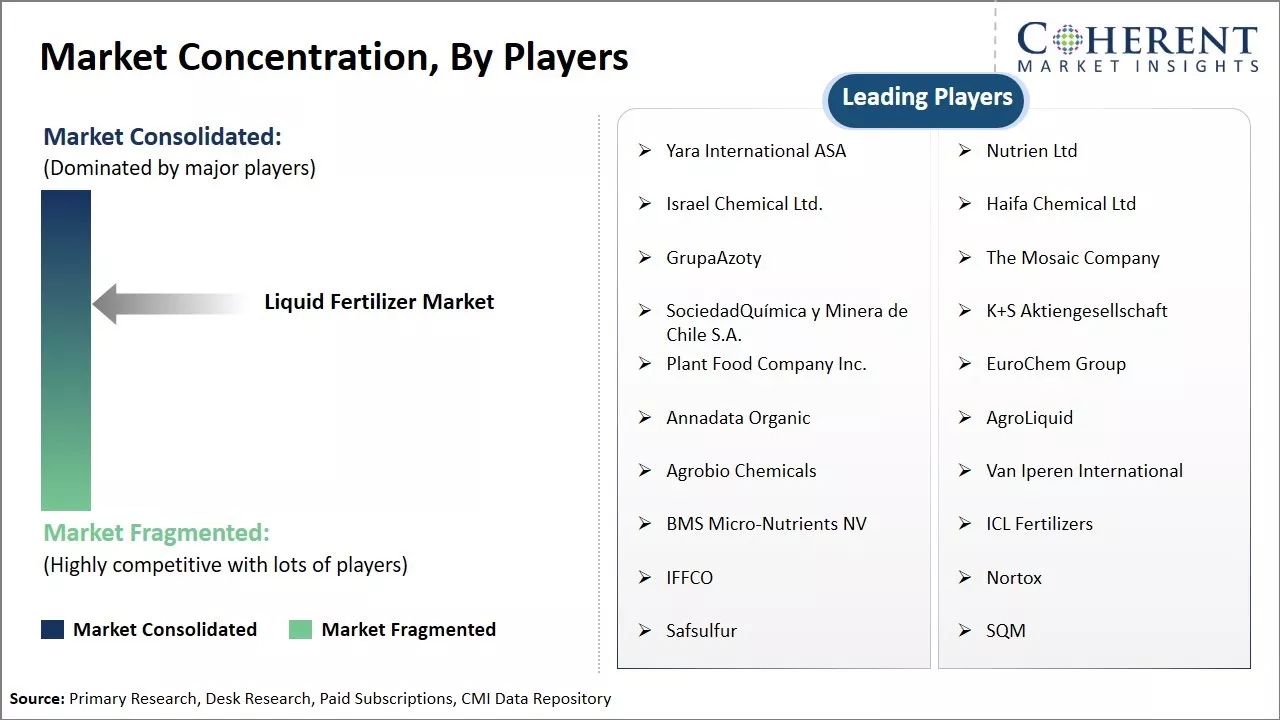Liquid Fertilizer Market Size and Forecast – 2025 to 2032
The liquid fertilizer market is estimated to be valued at USD 23.52 Bn in 2025 and is expected to reach USD 35.63 Bn by 2032, growing at a compound annual growth rate (CAGR) of 6.1% from 2025 to 2032.

To learn more about this report, Download Free Sample
Key Takeaways
- Based on Crop Type, Cereals & Grains segment is projected to account for 42. 0% shares of the global market in 2025, owing to its wide usage in animal feed.
- Based on Compound, the Calcium Ammonium Nitrate (CAN) segment is expected to capture 38.3% share of the market in 2025, due to its balanced nutritional profile.
- Based on Type, the Nitrogen segment is projected to command 42.1% share of the market in 2025, due to its major role in plant physiology and development.
- Based on Region, North America is set to dominate the global market with a 40.4% share in 2025.
Market Overview
The growing adoption of precision farming and environment-friendly fertilizers is supporting the increased usage of liquid fertilizers among farmers globally. The liquid fertilizer market is expected to witness significant growth over the forecast period. The rise in population and declining availability of cultivable land is increasing the demand for high crop yields, propelling the need for efficient nutrient delivery systems like liquid fertilizers. Furthermore, liquid fertilizers have better absorption rate and ensure uniform distribution of nutrients to plants, thereby improving crop quality and yield.
Current Events and their Impact
|
Current Event |
Description and its Impact |
|
Technological Advancements in Precision Agriculture |
|
|
Climate Change and Extreme Weather Events |
|
Uncover macros and micros vetted on 75+ parameters: Get instant access to report
Liquid Fertilizer Import Export Analysis
Between November 2023 and October 2024, 1,857 shipments of Liquid Fertilizer were exported globally by 489 exporters to 434 buyers — a 28% increase over the previous year. In October 2024 alone, 142 shipments were recorded.
Vietnam, the United States, and India were the top destination countries. The leading exporters were the United States (953 shipments), Turkey (700), and Chile (469).
Liquid Fertilizers Market Insights, By Crop Type - Increased Feed Demand Drives the Cereals & Grains Segment
In terms of crop type, cereals & grains contributes 42.0% share of the market owing to its widespread use as a key ingredient in animal feed such as poultry, cattle, and aquafeed. Cereal crops like corn, wheat, and barley are planted on massive scales globally to meet the burgeoning demand for animal proteins. Annual global cereal production is approximately 2,500 million tons. Maize (corn), wheat, and rice make up over 75% of this total grain output.
As population and incomes rise, consumption of meat, dairy and seafood has increased substantially. This amplified demand for feed grains in turn promotes higher usage of fertilizers to maximize crop yields from cereal farming. Liquid formulations are increasingly preferred over solid fertilizers for cereal crops since they allow for precise application of nutrients, higher absorption rates and more uniform distribution in large agricultural fields.
With continuing urbanization and diet changes worldwide, demand for animal proteins will grow steadily, maintaining the need for huge volumes of cereals and feed grains to be produced each season. This sustained production requirement drives robust usage of liquid fertilizers to nourish cereal crops.
Liquid Fertilizers Market Insights, By Compounds - CAN Dominates due to Balanced Nutrition
In terms of compounds, Calcium Ammonium Nitrate (CAN) contributes 38.3% share of the market owing to its balanced nutritional profile. CAN contains nitrogen, calcium, and nitrates in readily available forms for plant uptake. The 28% nitrogen content in CAN makes it an appealing choice for boosting crop growth and productivity.
In addition, it supplies important calcium which is instrumental in nutrient transport, cell structure, and enzyme activity within plants. CAN also improves soil structure and aeration due to its neutral pH levels. Its balanced nourishment from three essential elements allows farmers to maximize yields from a single fertilizer application.
In March 2024, Argus launched the world's first price assessments for low and zero-carbon calcium ammonium nitrate (CAN), a key nitrogen fertilizer widely used in Europe. The assessments reflect production costs using blue ammonia (from natural gas with carbon capture) or green ammonia (from renewable energy).
Liquid Fertilizers Market Insights, By Type - Nitrogen Dominates due to Vital Role in Plant Physiology
In terms of type, nitrogen contributes 42.1% share of the market, owing to its pivotal role in plant physiology and development. Nitrogen is a fundamental component of crucial molecules like chlorophyll, proteins, nucleic acids, and enzymes that drive photosynthesis, metabolism, and overall growth in crops.
Adequate nitrogen supply is essential for healthy leaf color and coverage, strong stalks or stems, robust tillering, and heavy seed or fruit production. Its importance stems from nitrogen being the most common limiting nutrient in soils globally as nitrogenous compounds volatize or leach more readily than other elements. Continuous nitrogen deficiency can severely curb a crop's genetic yield potential.
For instance, in May 2023, IFFCO has set up manufacturing facilities for the production of Nano DAP Fertilisers at Kalol, Kandla in Gujarat, and Paradeep in Orissa. Nano DAP Liquid is an efficient source of Nitrogen & Phosphorus and helps in overcoming Nitrogen & Phosphorus deficiencies in plants.
Regional Insights

To learn more about this report, Download Free Sample
North America Liquid Fertilizers Market Analysis and Trends
North America has established itself as the dominant region in the global liquid fertilizer market with 40.4% of the market share. With a strong agricultural industry and vast cultivable land, liquid fertilizers have gained widespread acceptance among farmers in countries like the U.S.
Leading manufacturers have set up production facilities across major farming states to ensure steady supply and meet local demand requirements. Farmers prefer liquid varieties due to the easy application process and higher nutrient absorption rates compared to traditional granular fertilizers. States like Iowa, Illinois, and Nebraska are some of the top consumers nationally.
For instance, in June 2023, ICL launched a new line of foliar and fertigation solutions for the North American market under its established Nova brand of water-soluble fertilizers.
Asia Pacific Liquid Fertilizers Market Analysis and Trends
The Asia Pacific region has been witnessing impeccable growth and is emerging as the fastest expanding market globally. China dominates regional consumption figures but other Southeast Asian countries like India and Indonesia are displaying elevated growth rates. Favorable government initiatives to boost farm outputs through initiatives like 'Green Revolution' in India have worked as a catalyst.
Manufacturers from China, South Korea, and Australia have augmented local manufacturing to take advantage of untapped potential. Strong economic gains coupled with rising incomes are propelling the Asia Pacific market upward. Import levels remain modest since domestic manufacturing has picked up well. However, prices may edge higher than North America owing to higher freight costs and increased local manufacturing investments.
For instance, in February 2024, Syngenta Group’s MAP unveiled its Endos™ Enhanced Efficiency Fertilizer in China
Liquid Fertilizers Market Outlook Country-Wise
U.S. Liquid Fertilizers Market Trends
The U.S. liquid fertilizers market is experiencing steady growth, driven by the rising adoption of precision agriculture, increasing demand for high-efficiency nutrient delivery systems, and the need for sustainable farming practices.
Liquid fertilizers are favored for their quick nutrient availability and compatibility with technologies like fertigation and foliar application, making them especially popular among growers of corn, soybeans, fruits, and vegetables.
For instance, in October 2024, ICL unveiled its new fertilizers system in North America Market.
China Liquid Fertilizers Market Trends
China's liquid fertilizers market is experiencing significant growth, driven by advancements in precision agriculture and a strong governmental focus on sustainable farming practices.
Furthermore, the Chinese government is promoting the use of biostimulant-infused liquid fertilizers to enhance soil health and reduce reliance on synthetic nutrients (SkyQuest). These developments indicate a robust and evolving liquid fertilizers market in China, with a strong emphasis on innovation and sustainability.
For instance, in January 2025, Hangzhou, announced the product launch event for its crop health product Wojiarun®. This is a new-generation water-soluble secondary fertilizer, which is also a new-generation calcium fertilizer developed by Bayer, launched with upgraded brand, formula and purity. The launch of the product is a demonstration of Bayer’s strong commitment to fertilizer research and manufacture in China.
Market Report Scope
Liquid Fertilizer Market Report Coverage
| Report Coverage | Details | ||
|---|---|---|---|
| Base Year: | 2024 | Market Size in 2025: | USD 23.52 Bn |
| Historical Data for: | 2020 To 2024 | Forecast Period: | 2025 To 2032 |
| Forecast Period 2025 to 2032 CAGR: | 6.1% | 2032 Value Projection: | USD 35.63 Bn |
| Geographies covered: |
|
||
| Segments covered: |
|
||
| Companies covered: |
Yara International ASA, Nutrien Ltd, Israel Chemical Ltd., Haifa Chemical Ltd, GrupaAzoty, The Mosaic Company, SociedadQuímica y Minera de Chile S.A., K+S Aktiengesellschaft, Plant Food Company Inc., EuroChem Group, Annadata Organic, AgroLiquid, Agrobio Chemicals, Van Iperen International, BMS Micro-Nutrients NV, ICL Fertilizers, IFFCO, Nortox, Safsulfur, and SQM |
||
| Growth Drivers: |
|
||
| Restraints & Challenges: |
|
||
Uncover macros and micros vetted on 75+ parameters: Get instant access to report
Market Trends
Rising Global Population
As the world's population continues to grow at a significant pace, the demand for food is expected to rise exponentially in the coming years. It is estimated that the global population will reach nearly 10 billion by 2050 which will require enormous amount of food production. With limited agricultural land available and degrading soil health in many regions, there is an urgent need to boost crop yields in a sustainable manner.
Liquid fertilizers can play a vital role here as they help maximize the nutrient uptake by plants. Being soluble in water, liquid fertilizers are easily absorbed by plant roots and ensure that key macro and micronutrients reach different parts of the crop. This leads to higher productivity even when applied in smaller quantities. With agricultural outputs needing to increase substantially, liquid fertilizers are expected to gain more popularity among farmers globally as they seek to feed the swelling population.
Increasing
Organic Farming
Trend
Consumers have become more aware of the ill-effects of excessive use of chemical fertilizers on soil health and environment. There is a rising preference for organic and natural products grown through sustainable agricultural methods. In response, many farmers are gradually shifting towards organic cultivation practices. In July 2025, Thane Municipal Corporation launched an experimental organic farming project on a 1.5-acre civic plot in Patlipada, Ghodbunder Road. Such projects are accelerating the liquid fertilizer market demand.
Market Opportunities: Advantages of Precise Nutrient Application
The ability to precisely apply nutrients promotes higher yields for farmers. This targeted approach also reduces fertilizer use and lowers costs over time. As the agricultural industry faces pressure to sustainably intensify production, liquids provide a solution. Their flexibility allows formulations tailored for specific crops and soils. Manufacturers stand to benefit from expanded market share if these advantages reach more end users.
Analyst Opinion (Expert Opinion)
- The liquid fertilizers market is poised to experience steady growth over the coming years. Farmers across major agricultural regions are increasingly adopting liquid fertilizers due to their ease of application and higher nutrient absorption rate by plants. North America is expected to dominate the global market, owing to strong agricultural industry and vast cultivable land.
- The emergence of precision farming and fertigation techniques are likely to drive higher consumption of liquid fertilizers. These methods allow for precise application of nutrients to plants based on their needs. They minimize wastage and increase overall farm productivity. Also, the liquid form offers affordable and efficient options to small and marginal farmers.
Liquid Fertilizer Industry News
- In May 2025, Portugal’s agricultural sector marked the launch of Liquiadubos, a homegrown company set to open a new factory producing NPK-based liquid fertilizers—vital for the growth of irrigated crops with key nutrients like nitrogen, phosphorus, and potassium.
- In December 2024, Fertiliser major IFFCO, introduced nano liquid urea and nano liquid DAP, has now developed nano NPK nutrient and sought the government's approval to launch it in the market.
- In November 2024, National Fertilizers (NFL) announced that it will begin manufacturing nano urea at its Nangal plant.
Market Segmentation
- Crop Type Insights (Revenue, USD Bn & KT, 2020 - 2032)
- Cereals & Grains
- Oilseed & Pulses
- Fruits & Vegetables
- Others (Nursery plants, etc.)
- Compound Insights (Revenue, USD Bn & KT, 2020 - 2032)
- Calcium Ammonium Nitrate (CAN)
- Urea-Ammonium Nitrate (UAN)
- Potassium Nitrate
- Phosphorus Pentoxide (P 0)
- Others (Boron, etc.)
- Type Insights (Revenue, USD Bn & KT, 2020 - 2032)
- Nitrogen
- Phosphorus
- Potash
- Micronutrients
- Application Insights (Revenue, USD Bn & KT, 2020 - 2032)
- Soil
- Foliar
- Fertigation
- Agricultural fields
- Hydroponics
- Others (Starter solutions, etc.)
- Regional Insights (Revenue, USD Bn & KT, 2020 - 2032)
- North America
- U.S.
- Canada
- Latin America
- Brazil
- Argentina
- Mexico
- Rest of Latin America
- Europe
- Germany
- U.K.
- Spain
- France
- Italy
- Russia
- Rest of Europe
- Asia Pacific
- China
- India
- Japan
- Australia
- South Korea
- ASEAN
- Rest of Asia Pacific
- Middle East & Africa
- GCC Countries
- Israel
- Rest of Middle East & Africa
- Key Players Insights
- Yara International ASA
- Nutrien Ltd
- Israel Chemical Ltd.
- Haifa Chemical Ltd
- GrupaAzoty
- The Mosaic Company
- SociedadQuímica y Minera de Chile S.A.
- K+S Aktiengesellschaft
- Plant Food Company Inc.
- EuroChem Group
- Annadata Organic
- AgroLiquid
- Agrobio Chemicals
- Van Iperen International
- BMS Micro-Nutrients NV
- ICL Fertilizers
- IFFCO
- Nortox
- Safsulfur
- SQM
Sources
Primary Research Interviews
- Liquid fertilizer manufacturers and suppliers
- Agricultural distributors and retailers
- Farm management professionals and agronomists
- E-commerce platform operators in agriculture sector
- Others
Databases
- FAO Statistical Database (FAOSTAT)
- USDA National Agricultural Statistics Service
- Global Trade Atlas
- Fertilizers Europe Database
- Others
Magazines
- Fertilizer Focus
- Farm Chemicals International
- Crops & Soils Magazine
- AgriMarketing Magazine
- Precision Ag
- Others
Journals
- Journal of Plant Nutrition
- Fertilizer Research
- Agricultural Systems Journal
- Others
Newspapers
- AgriNews
- Farm Progress
- The Western Producer
- AgWeb News
- Farm Journal
- Others
Associations
- International Fertilizer Association (IFA)
- The Fertilizer Institute (TFI)
- European Fertilizer Manufacturers Association (Fertilizers Europe)
- Association of American Plant Food Control Officials (AAPFCO)
- Fluid Fertilizer Foundation
- Others
Public Domain Sources
- United Nations Food and Agriculture Organization (FAO) reports
- World Bank agricultural data
- Government agricultural ministry publications
- EPA fertilizer regulations and guidelines
- Others
Proprietary Elements
- CMI Data Analytics Tool
- Proprietary CMI Existing Repository of information for last 8 years
*Definition : The liquid fertilizer market consists of plant nutrients that are supplied to agricultural crops and turf in a liquid form rather than dry powder or granular form. Liquid fertilizers are easy to apply through irrigation systems and spread uniformly over soil. They are quickly absorbed by crops and more readily available to plants compared to dry granular fertilizers. The liquid fertilizer market offers products that are designed to provide readily available and balanced nutrition to support healthy plant growth.
Share
Share
About Author
Yash Doshi is a Senior Management Consultant. He has 12+ years of experience in conducting research and handling consulting projects across verticals in APAC, EMEA, and the Americas.
He brings strong acumen in helping chemical companies navigate complex challenges and identify growth opportunities. He has deep expertise across the chemicals value chain, including commodity, specialty and fine chemicals, plastics and polymers, and petrochemicals. Yash is a sought-after speaker at industry conferences and contributes to various publications on topics related commodity, specialty and fine chemicals, plastics and polymers, and petrochemicals.
Missing comfort of reading report in your local language? Find your preferred language :
Transform your Strategy with Exclusive Trending Reports :
Frequently Asked Questions
EXISTING CLIENTELE
Joining thousands of companies around the world committed to making the Excellent Business Solutions.
View All Our Clients


